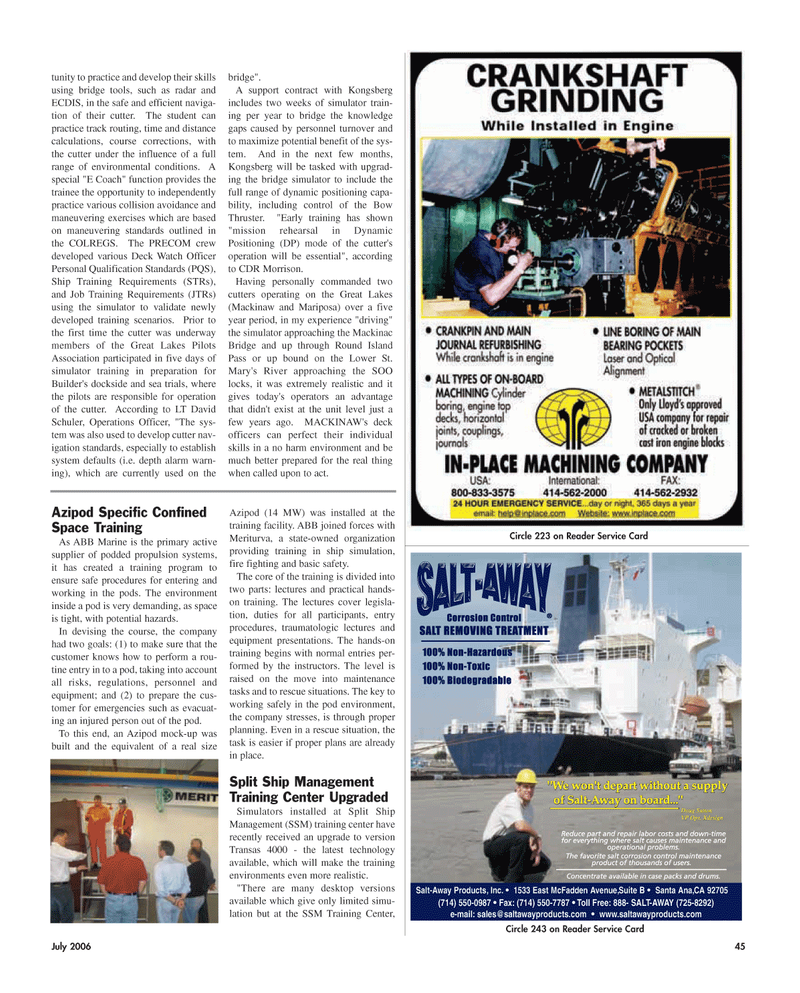
Page 45: of Maritime Reporter Magazine (July 2005)
The Satellite Communications Edition
Read this page in Pdf, Flash or Html5 edition of July 2005 Maritime Reporter Magazine
July 2006 45 tunity to practice and develop their skills using bridge tools, such as radar and
ECDIS, in the safe and efficient naviga- tion of their cutter. The student can practice track routing, time and distance calculations, course corrections, with the cutter under the influence of a full range of environmental conditions. A special "E Coach" function provides the trainee the opportunity to independently practice various collision avoidance and maneuvering exercises which are based on maneuvering standards outlined in the COLREGS. The PRECOM crew developed various Deck Watch Officer
Personal Qualification Standards (PQS),
Ship Training Requirements (STRs), and Job Training Requirements (JTRs) using the simulator to validate newly developed training scenarios. Prior to the first time the cutter was underway members of the Great Lakes Pilots
Association participated in five days of simulator training in preparation for
Builder's dockside and sea trials, where the pilots are responsible for operation of the cutter. According to LT David
Schuler, Operations Officer, "The sys- tem was also used to develop cutter nav- igation standards, especially to establish system defaults (i.e. depth alarm warn- ing), which are currently used on the bridge".
A support contract with Kongsberg includes two weeks of simulator train- ing per year to bridge the knowledge gaps caused by personnel turnover and to maximize potential benefit of the sys- tem. And in the next few months,
Kongsberg will be tasked with upgrad- ing the bridge simulator to include the full range of dynamic positioning capa- bility, including control of the Bow
Thruster. "Early training has shown "mission rehearsal in Dynamic
Positioning (DP) mode of the cutter's operation will be essential", according to CDR Morrison.
Having personally commanded two cutters operating on the Great Lakes (Mackinaw and Mariposa) over a five year period, in my experience "driving" the simulator approaching the Mackinac
Bridge and up through Round Island
Pass or up bound on the Lower St.
Mary's River approaching the SOO locks, it was extremely realistic and it gives today's operators an advantage that didn't exist at the unit level just a few years ago. MACKINAW's deck officers can perfect their individual skills in a no harm environment and be much better prepared for the real thing when called upon to act.
Circle 223 on Reader Service Card
Salt-Away Products, Inc. • 1533 East McFadden Avenue, Suite B • Santa Ana, CA 92705 (714) 550-0987 • Fax: (714) 550-7787 • Toll Free: 888- SALT-AWAY (725-8292) e-mail: [email protected] • www.saltawayproducts.com
Circle 243 on Reader Service Card
Azipod Specific Confined
Space Training
As ABB Marine is the primary active supplier of podded propulsion systems, it has created a training program to ensure safe procedures for entering and working in the pods. The environment inside a pod is very demanding, as space is tight, with potential hazards.
In devising the course, the company had two goals: (1) to make sure that the customer knows how to perform a rou- tine entry in to a pod, taking into account all risks, regulations, personnel and equipment; and (2) to prepare the cus- tomer for emergencies such as evacuat- ing an injured person out of the pod.
To this end, an Azipod mock-up was built and the equivalent of a real size
Azipod (14 MW) was installed at the training facility. ABB joined forces with
Meriturva, a state-owned organization providing training in ship simulation, fire fighting and basic safety.
The core of the training is divided into two parts: lectures and practical hands- on training. The lectures cover legisla- tion, duties for all participants, entry procedures, traumatologic lectures and equipment presentations. The hands-on training begins with normal entries per- formed by the instructors. The level is raised on the move into maintenance tasks and to rescue situations. The key to working safely in the pod environment, the company stresses, is through proper planning. Even in a rescue situation, the task is easier if proper plans are already in place.
Split Ship Management
Training Center Upgraded
Simulators installed at Split Ship
Management (SSM) training center have recently received an upgrade to version
Transas 4000 - the latest technology available, which will make the training environments even more realistic. "There are many desktop versions available which give only limited simu- lation but at the SSM Training Center,
MR JULY2006 #6 (41-48).qxd 7/5/2006 12:02 PM Page 45

 44
44

 46
46
